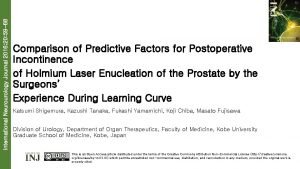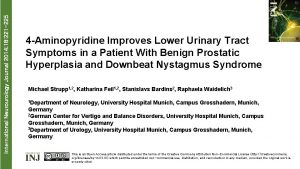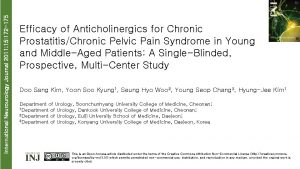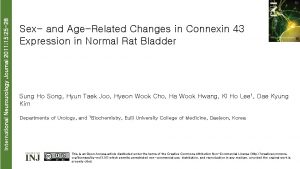International Neurourology Journal 2011 15 216 221 Analysis









- Slides: 9

International Neurourology Journal 2011; 15: 216 -221 Analysis of Prescriptions of Alpha-Blockers and Phosphodiesterase 5 Inhibitors from the Urology Department and Other Departments Dong Hyuk Kang, Joo Yong Lee, Jae Hoon Chung, Hee Ju Cho 1, Jeong Man Cho 1, Hong Sang Moon, Yong Tae Kim, Tag Keun Yoo 1, Hong Yong Choi, Hae Young Park, Seung Wook Lee Department of Urology, Hanyang University College of Medicine, Seoul; 1 Department of Urology, Eulji General Hospital, Eulji University School of Medicine, Seoul, Korea This is an Open Access article distributed under the terms of the Creative Commons Attribution Non-Commercial License (http: //creativecommons. org/licenses/by-nc/3. 0/) which permits unrestricted non-commercial use, distribution, and reproduction in any medium, provided the original work is properly cited.

International Neurourology Journal 2011; 15: 216 -221 INTRODUCTION • We analyzed the prescriptions of alpha-blockers and phosphodiesterase 5 inhibitors (PDE 5 Is) in the urology department as well as in other departments of the general hospital. MATERIALS AND METHODS • We investigated the frequency of prescription of alpha-blockers and PDE 5 Is from 3 general hospitals from January 1, 2007 to December 31, 2009. • For alpha-blockers, data were collected from patients to whom alphablockers were prescribed from among patients recorded as having benign prostatic hyperplasia according to the 5 th Korean Standard Classification of Diseases. • For PDE 5 Is, data were collected from patients to whom PDE 5 Is were prescribed by the urology department and by other departments. • Alpha-blockers were classified into tamsulosin, alfuzosin, doxazosin, and terazosin, whereas PDE 5 Is were classified into sildenafil, tadalafil, vardenafil, udenafil, and mirodenafil.

International Neurourology Journal 2011; 15: 216 -221 RESULTS • Alpha-blockers were prescribed to 11, 436 patients in total over 3 years, and the total frequency of prescriptions was 68, 565. • Among other departments, the nephrology department had the highest frequency of prescription of 3, 225 (4. 7%), followed by the cardiology (3, 101, 4. 5%), neurology (2, 576, 3. 8%), endocrinology (2, 400, 3. 5%), pulmonology (1, 102, 1. 6%), and family medicine (915, 1. 3%) departments in order. • PDE 5 Is were prescribed to 2, 854 patients in total over 3 years, and the total frequency of prescriptions was 10, 558. • The prescription frequency from the urology department was 4, 900 (46. 4%). Among other departments, the endocrinology department showed the highest prescription frequency of 3, 488 (33. 0%), followed by the neurology (542, 5. 1%), cardiology (467, 4. 4%), and family medicine (407, 3. 9%) departments in order. CONCLUSIONS • A high percentage of prescriptions of alpha-blockers and PDE 5 Is were from other departments. For more specialized medical care by urologists is required in the treatment of lower urinary tract symptoms and erectile dysfunction.

International Neurourology Journal 2011; 15: 216 -221 Fig. 1. Comparison of prescription of alpha-blockers for 3 years. UR, urology; NE, nephrology; CV, cardiology; NR, neurology; EM, endocrinology; CM, pulmonology; FM, family medicine; RE, rehabilitation medicine; NS, neurosurgery; GE, gastroenterology; ER, emergency medicine; RM, rheumatology; HO, hemato-oncology; TS, chest surgery; NP, neuropsychiatrics; GS, general surgery; OS, orthopaedic surgery; ID, infectious disease; OL, otolaryngology; DM, dermatology.

International Neurourology Journal 2011; 15: 216 -221 Fig. 2. The percentage of prescription of alpha-blockers from the urology department and from the other departments. a)Pearson’s chi-square test.

International Neurourology Journal 2011; 15: 216 -221 Fig. 3. Yearly variations in the prescription of alpha-blockers (A) From all departments; (B) From departments other than the urology department.

International Neurourology Journal 2011; 15: 216 -221 Fig. 4. Comparison of prescription of phosphodiesterase 5 inhibitors for 3 years. UR, urology; EM, endocrinology; NR, neurology; CV, cardiology; GE, gastroenterology; NE, nephrology; RM, rheumatology; NP, neuropsychiatrics; TS, chest surgery; PD, pediatrics; NS, neurosurgery; OG, obsterics-gynecology; RE, rehabilitation medicine; GS, general surgery; CM, pulmonology; OS, orthopaedic surgery; DM, dermatology; OT, ophthalmology; ER, emergency medicine; ID, infectious disease; RT, therapeutic radiology; SP, pediatric surgery.

International Neurourology Journal 2011; 15: 216 -221 Fig. 5. The percentage of prescription of phosphodiesterase 5 inhibitors from the urology department and from the other departments. a)Pearson’s chi-square test.

International Neurourology Journal 2011; 15: 216 -221 Fig. 6. Yearly variations in the prescription of phosphodiesterase 5 inhibitors (A) From all departments; (B) From departments other than the urology department.

















